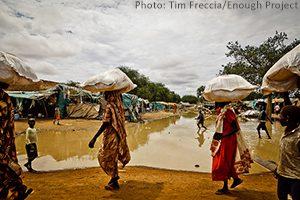
IDPs in Turalei. May 2011.
This blogpost is part one of a two-part blog series on the ongoing tensions in Abyei. The blogposts were authored by a guest blogger whose name has been withheld for security reasons. Click here to read part two: Pushing for Progress on Abyei.
On May 26, 2017, news outlets in Sudan and South Sudan reported that governments in Khartoum and Juba had received invitations from the African Union to resume talks on the status of the disputed Abyei region. This news came less than two weeks after the U.N. Security Council released a statement calling for both parties to resume negotiations to implement the provisions of the June 2011 Agreement on Temporary Arrangements for the Administration and Security of the Abyei Area, and to conclude the process of resolving the final status of Abyei within the next five months.
The June 2011 Agreement was signed less than a month after massive military clashes between the Sudanese Armed Forces (SAF) and the Sudan People’s Liberation Army (SPLA) in Abyei. More than 100,000 civilians were displaced in the three weeks following the capture of Abyei town by Sudanese forces in May 2011.
The June 2011 Agreement provided for the full withdrawal of both forces – the SAF and the SPLA – from Abyei, and their replacement with a U.N.-backed Ethiopian peacekeeping force to maintain security and protect humanitarian interventions and civilian populations in the region. The Agreement also stipulated the establishment of a temporary joint Sudan and South Sudan civilian administration, police, and legislature in Abyei. The Agreement called for the temporary arrangements to be followed by a referendum to determine the final status of Abyei.
A peacekeeping force, the United Nations Interim Security Force for Abyei (UNISFA), was fully deployed, but both parties to the agreement have since failed to agree on the establishment of a joint administration. Elements of the SAF continue to maintain a presence in the northern part of Abyei. For more than 20 months, the Abyei Joint Oversight Committee (AJOC), a joint mechanism entrusted with monitoring implementation of the Agreement, failed to convene its monthly meetings due to political tensions arising from multiple incidents in the region.
In May of this year, the U.N. Security Council renewed UNISFA’s mandate, but with a slight reduction in the number of forces. It also urged both Sudan and South Sudan to demonstrate their commitment to previously signed agreements on Abyei. Six years after the signing of the June 2011 Agreement, both parties have failed to live up to their agreed commitments.
The two countries have moral and political obligations to the residents of Abyei to demonstrate a certain level of commitment to finding a permanent resolution. A series of political and security setbacks in Abyei has raised levels of frustration among local communities. The two devastating armed conflicts that took place in Abyei in May 2008 and May 2011, along with the suspension of the 2011 referendum for Abyei, have all contributed to this heightened level of frustration. Dissatisfaction among the Ngok Dinka is particularly high since the 2013 killing of the paramount leader, Chief Kuol Deng Kuol, and the broad rejection of the results of a unilateral community referendum in October 2013 in which they voted overwhelmingly to join South Sudan.
In addition, both countries have exchanged accusations of harboring and supporting each other’s armed opposition groups. Recently, South Sudan’s SPLA deputy spokesperson accused Sudan of supporting rebels who attacked the South Sudanese towns of Ghabat and Kuek in early June.
These challenges, in addition to other internal issues in both countries, make the prospect of resolving Abyei’s final status increasingly remote. But Sudan and South Sudan have to arrive at a settlement to their differences over Abyei and put an end to the long and sometimes bloody conflict in the region – there is no palatable alternative.
There is a possibility of reaching a middle ground agreement for a temporary administrative status that guarantees at least the delivery of services and development in the Abyei area. An agreed temporary administrative arrangement can help ensure improved security for both Ngok Dinka and Misseriya communities, open up access to humanitarian actors to assist civilian populations, and allow for the formation of law enforcement institutions at the local level.
This is part one of a two-part blog series on the ongoing tensions in Abyei. Click here to read part two: Pushing for Progress on Abyei.

